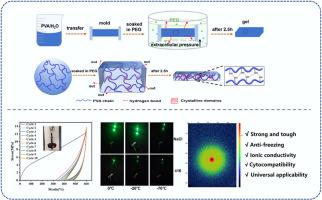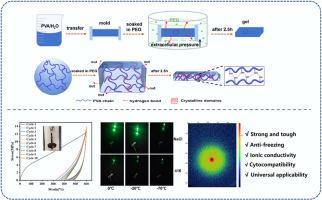Cell membrane–inspired reverse dialysis approach for preparation of hydrogels with tunable mechanical properties of high strength and toughness
IF 4.5
2区 化学
Q2 POLYMER SCIENCE
引用次数: 0
Abstract
Hydrogels are important biomaterials that have vital applications in multiple fields. The effective preparation of tough hydrogels that meet the requirements of multifunctional application remains a great challenge. Inspired by the water absorption and loss across cell membranes in nature, a novel strategy of reverse dialysis (external hydrophilic substance regulates the structure of internal polymer) was proposed. The strategy involves regulating the difference in internal and external osmotic pressure, which, in turn, regulates the hydrogen bond formation in the polymer chain. Compared to the traditional methods of hydrogel preparation, the preparation time in this study is restricted to within 3 h. During the reverse dialysis process, nanofiber-like structures were successfully formed inside the hydrogel. Especially at low concentrations of PVA (5 % w/v), ordered fiber structures are formed. The tensile strength and toughness can be modulated within the approximate range of 0.24–41.52 MPa and 1.42–222.62 MJ/m3, respectively. The hydrogel was found to exhibit good biocompatibility, ionic conductivity (up to 7.80 S/m), and frost resistance; it can be employed in supercapacitors as a solid electrolyte. The reverse dialysis method described in this study provides a sound framework for the preparation of strong and tough hydrogels with multifunctional applications.


膜启发的反透析方法制备具有可调机械性能的高强度和韧性的水凝胶
水凝胶是一种重要的生物材料,在许多领域都有重要的应用。有效制备满足多功能应用要求的强韧水凝胶仍然是一个巨大的挑战。受自然界细胞膜上的水分吸收和损失的启发,提出了一种新的反透析策略(外部亲水性物质调节内部聚合物的结构)。该策略包括调节内部和外部渗透压的差异,从而调节聚合物链中氢键的形成。与传统的水凝胶制备方法相比,本研究的制备时间限制在3小时以内。在反透析过程中,水凝胶内部成功形成了纳米纤维状结构。特别是在低浓度的PVA (5% w/v)下,纤维结构形成有序。拉伸强度和韧性可在0.24 ~ 41.52 MPa和1.42 ~ 222.62 MJ/m3的近似范围内调节。该水凝胶具有良好的生物相容性、离子电导率(高达7.80 S/m)和抗冻性;它可以用作超级电容器的固体电解质。本研究所描述的反透析方法为制备具有多功能应用的强韧性水凝胶提供了良好的框架。
本文章由计算机程序翻译,如有差异,请以英文原文为准。
求助全文
约1分钟内获得全文
求助全文
来源期刊

Polymer
化学-高分子科学
CiteScore
7.90
自引率
8.70%
发文量
959
审稿时长
32 days
期刊介绍:
Polymer is an interdisciplinary journal dedicated to publishing innovative and significant advances in Polymer Physics, Chemistry and Technology. We welcome submissions on polymer hybrids, nanocomposites, characterisation and self-assembly. Polymer also publishes work on the technological application of polymers in energy and optoelectronics.
The main scope is covered but not limited to the following core areas:
Polymer Materials
Nanocomposites and hybrid nanomaterials
Polymer blends, films, fibres, networks and porous materials
Physical Characterization
Characterisation, modelling and simulation* of molecular and materials properties in bulk, solution, and thin films
Polymer Engineering
Advanced multiscale processing methods
Polymer Synthesis, Modification and Self-assembly
Including designer polymer architectures, mechanisms and kinetics, and supramolecular polymerization
Technological Applications
Polymers for energy generation and storage
Polymer membranes for separation technology
Polymers for opto- and microelectronics.
 求助内容:
求助内容: 应助结果提醒方式:
应助结果提醒方式:


